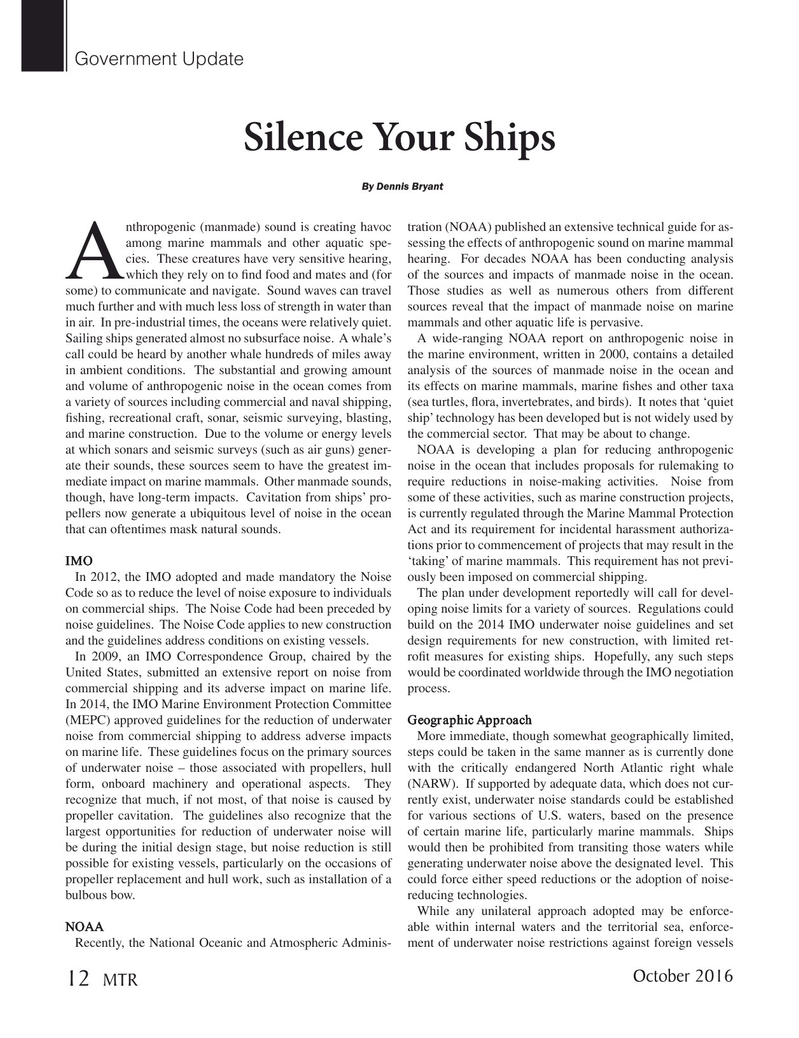
Page 12: of Marine Technology Magazine (October 2016)
AUV Operations
Read this page in Pdf, Flash or Html5 edition of October 2016 Marine Technology Magazine
Government Update
Silence Your Ships
By Dennis BryantBy Dennis Bryant nthropogenic (manmade) sound is creating havoc tration (NOAA) published an extensive technical guide for as- among marine mammals and other aquatic spe- sessing the effects of anthropogenic sound on marine mammal cies. These creatures have very sensitive hearing, hearing. For decades NOAA has been conducting analysis
Awhich they rely on to ? nd food and mates and (for of the sources and impacts of manmade noise in the ocean. some) to communicate and navigate. Sound waves can travel Those studies as well as numerous others from different much further and with much less loss of strength in water than sources reveal that the impact of manmade noise on marine in air. In pre-industrial times, the oceans were relatively quiet. mammals and other aquatic life is pervasive.
Sailing ships generated almost no subsurface noise. A whale’s A wide-ranging NOAA report on anthropogenic noise in call could be heard by another whale hundreds of miles away the marine environment, written in 2000, contains a detailed in ambient conditions. The substantial and growing amount analysis of the sources of manmade noise in the ocean and and volume of anthropogenic noise in the ocean comes from its effects on marine mammals, marine ? shes and other taxa a variety of sources including commercial and naval shipping, (sea turtles, ? ora, invertebrates, and birds). It notes that ‘quiet ? shing, recreational craft, sonar, seismic surveying, blasting, ship’ technology has been developed but is not widely used by and marine construction. Due to the volume or energy levels the commercial sector. That may be about to change.
at which sonars and seismic surveys (such as air guns) gener- NOAA is developing a plan for reducing anthropogenic ate their sounds, these sources seem to have the greatest im- noise in the ocean that includes proposals for rulemaking to mediate impact on marine mammals. Other manmade sounds, require reductions in noise-making activities. Noise from though, have long-term impacts. Cavitation from ships’ pro- some of these activities, such as marine construction projects, pellers now generate a ubiquitous level of noise in the ocean is currently regulated through the Marine Mammal Protection that can oftentimes mask natural sounds. Act and its requirement for incidental harassment authoriza- tions prior to commencement of projects that may result in the
IMO ‘taking’ of marine mammals. This requirement has not previ-
In 2012, the IMO adopted and made mandatory the Noise ously been imposed on commercial shipping.
Code so as to reduce the level of noise exposure to individuals The plan under development reportedly will call for devel- on commercial ships. The Noise Code had been preceded by oping noise limits for a variety of sources. Regulations could noise guidelines. The Noise Code applies to new construction build on the 2014 IMO underwater noise guidelines and set and the guidelines address conditions on existing vessels. design requirements for new construction, with limited ret-
In 2009, an IMO Correspondence Group, chaired by the ro? t measures for existing ships. Hopefully, any such steps
United States, submitted an extensive report on noise from would be coordinated worldwide through the IMO negotiation commercial shipping and its adverse impact on marine life. process.
In 2014, the IMO Marine Environment Protection Committee (MEPC) approved guidelines for the reduction of underwater Geographic Approach noise from commercial shipping to address adverse impacts More immediate, though somewhat geographically limited, on marine life. These guidelines focus on the primary sources steps could be taken in the same manner as is currently done of underwater noise – those associated with propellers, hull with the critically endangered North Atlantic right whale form, onboard machinery and operational aspects. They (NARW). If supported by adequate data, which does not cur- recognize that much, if not most, of that noise is caused by rently exist, underwater noise standards could be established propeller cavitation. The guidelines also recognize that the for various sections of U.S. waters, based on the presence largest opportunities for reduction of underwater noise will of certain marine life, particularly marine mammals. Ships be during the initial design stage, but noise reduction is still would then be prohibited from transiting those waters while possible for existing vessels, particularly on the occasions of generating underwater noise above the designated level. This propeller replacement and hull work, such as installation of a could force either speed reductions or the adoption of noise- bulbous bow. reducing technologies.
While any unilateral approach adopted may be enforce-
NOAA able within internal waters and the territorial sea, enforce-
Recently, the National Oceanic and Atmospheric Adminis- ment of underwater noise restrictions against foreign vessels
October 2016
MTR 12
MTR #8 (1-17).indd 12 MTR #8 (1-17).indd 12 9/27/2016 1:24:18 PM9/27/2016 1:24:18 PM

 11
11

 13
13
